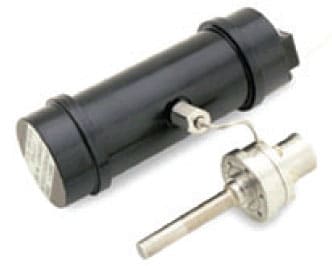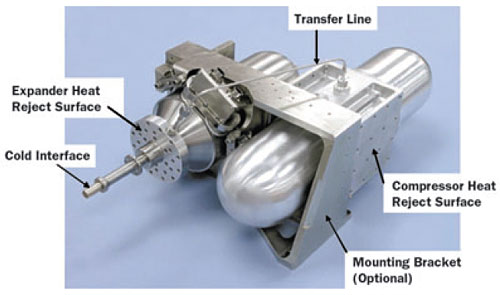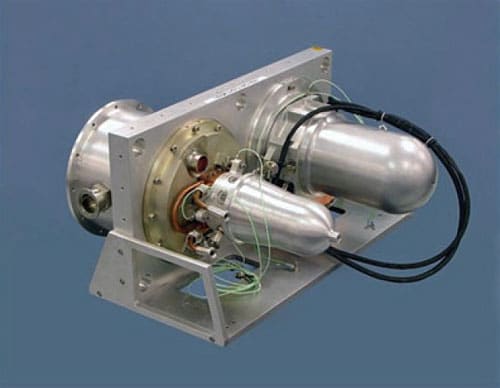Introduction
A review of the technical and market impediments overcome in the development and eventual acceptance of cryocoolers for space-borne applications may shine light on the prospects for the use of such mechanical refrigeration systems in more widespread commercial uses. This premise is explored by first reviewing space cooler development history, then considering some ongoing microcooler development activities, and finally looking for possibly instructive parallels between the two.
A Brief History of Space Cryocoolers
Cryocoolers are used extensively in defense applications, primarily for the cooling of infrared focal planes. More specifically, cryocoolers are typically used to cool intrinsic semiconductor type focal planes for mid-wave infrared (MWIR, nominally 3 to 5 micron wavelength) and long wave infrared (LWIR, nominally 9 to 12 micron) sensors. The most common detector materials for these applications are mercury-cadmium-telluride (HgCdTe) and indium antimonide (InSb), both of which require cooling to cryogenic temperatures to sufficiently reduce the random excitation of electrons from the valence band to the conduction band. These randomly excited electrons are indistinguishable to the focal plane electronics from the electrons which are excited by the incident photons at the desired wavelength. Thus maintaining low operating temperatures, as well as controlling numerous other design and operational parameters, is critical to the infrared sensor device performance.
Cryocoolers have been in widespread use for tactical military applications to meet ground, airborne, and shipboard infrared sensor cooling needs for at least thirty years. An example of a typical tactical cryocooler is depicted in Figure 1. The unit shown is of the linear Stirling cryocooler type, characterized by a dual opposed piston compressor utilizing voice coil type linear motors and a resonant Stirling expander. The cryocooler is designed so that the expander piston leads the compressor pistons by nominally ninety degrees to create refrigeration at the indicated cold tip. The vast majority of tactical military cryocoolers sold world wide are of this basic type.
 |
Figure 1. Tactical cryocooler. Raytheon Vision Systems 7060-260S. Produces nominally 0.5 W cooling at 77 K. Compressor (larger of two modules) is 11.4 cm long by 4.1 cm diameter. Total 7060-260S mass is 0.6 kg.
The first space cryocoolers were flown on experimental missions and performed successfully on orbit as long ago as 1972. However, it wasn’t until the late 1990s that cryocoolers began to be accepted for operational systems [1]. As we evaluate the near term potential for cryocoolers bridging the frontier into commercial electronics, this is indeed a potentially sobering consideration.
The basic reason that cryocoolers became accepted so much earlier for tactical military systems was that a limited operational life (hundreds of hours) was acceptable. The airborne, ground, or shipboard system could be accessed, retrofit with a new cryocooler, and reentered into service. This is not generally the case for space systems, which typically require 8+ year unattended operational life. More advanced cryocooler technology was required to meet these more stringent lifetime and reliability objectives.
Numerous technical approaches have been proposed and pursued, but the most widely used class of space cryocoolers is the so-called “Oxford class,” which includes Stirling and pulse tube coolers. The Oxford class cryocoolers, so termed because the seminal work in developing this design approach came out of Oxford University [2], are similar to the more prevalent tactical coolers. The moving pistons in the Oxford class machines are supported by flexures (instead of coil springs) that provide the required axial compliance in the stroke direction and extremely high stiffness in the radial direction. This enables the use of extremely small piston-to-cylinder clearances, yielding what is effectively a “clearance seal” in that the mass flow rate past the seal is a small fraction (typically ~1%) of the mass flow rate produced. Thus rubbing between the pistons and the cylinders that occurs in tactical coolers is eliminated. Furthermore, the flexures are designed for infinite fatigue life, effectively eliminating that failure mode, too.
 |
Figure 2. Raytheon Stirling One-Stage (RS1) Cryocooler. Key integration features noted. Produces nominally 4 W refrigeration at 60 K for about 120 W input power. Mass ~ 13 kg. Total packaging volume is 51 cm x 28 cm x 20 cm.
The original Oxford class cryocoolers used Stirling expanders with a moving piston. Pulse tube expanders, which operate on fundamentally the same thermodynamic cycle, have become more prominent over the past ten years. The relative attractiveness of the pulse tube largely derives from the absence of moving parts in the expander and the inherent reliability advantages so afforded [3]. Two examples of space cryocoolers are shown in Figures 2 and 3. The single stage Stirling shown in Figure 2 was manufactured by Hughes Aircraft (now Raytheon) and is very similar to the cooler flown on shuttle mission STS-85 in 1995 [4]. The two stage cooler shown in Figure 3 is a novel Stirling/pulse tube hybrid nearing flight readiness in its development cycle [5].
 |
Figure 3. Raytheon Stirling / Pulse Tube Two-Stage (RSP2) Cryocooler. Produces 2.6 W at 35 K and over 16 W at 85 K simultaneously for 500 W input power (compared to the 120 W design shown in Figure 2). This is exemplary of the present trend in space cryocoolers towards higher capacities to meet the demands of large and more capable space IR sensors. This is a nominally 22 kg cooler with overall package size of 56 cm x 46 cm x 20 cm.
The corner has been turned and space cryocoolers are now a baseline space infrared sensor component. However, it took nearly 40 years to get from the first successful flights in 1972 to this point! Is this indicative of the path ahead for miniaturized cryocoolers for commercial electronics applications? Perhaps. With this space cooler development history in mind, let us now consider the emerging miniature cryocooler technology development activities and look for parallels.
Miniaturized and Micro Cryocoolers � Applications
DARPA is presently sponsoring a program called Micro Cryogenic Coolers (MCC), and the list of targeted applications is impressively broad. The list includes IR detectors, low noise amplifiers, front-end passives in communication systems, and next generation nano-scale devices [6]. The basic objective is to achieve a reduction in the size of the cooling system to match the size of the device being cooled, which DARPA asserts will enable a reduction in the size of the overall system and the power consumption required for the cooling system.
Although processor cooling is not cited by DARPA as a primary application, this author contends that the same types of devices being developed for MCC may well have relevance for processor cooling. For example, a miniature cryocooler designed for, say, 50 mW cooling at 77 K may be operated at 233 K for processor cooling as envisioned by Peeples, et al. [7]. Assuming a roughly equivalent percent of Carnot, that same cooler will produce nearly 0.5 Watt at 233 K. Similarly, the same type of cooler might prove useful for near-ambient thermal management, competing with the Embraco compressor-based approach described by Mongia, et al. [8]. Thus the assertion here is that these miniature “cryogenic” coolers may well have relevance for applications that extend well above the 120 K temperature limit typically reserved for the term “cryogenic.”
What exactly constitutes a “micro cryocooler” is an unsettled question at present. Most of the ongoing developments in this class target cooling requirements believed achievable with between 1 W to 10 W of input power. This typically means targeted cooling loads in the tens of milliwatts from 70 K to 160 K. To help put the discussion in context, I will point out that this puts these “micro cryocoolers” at one to two orders of magnitude smaller than the present generation of smaller commercial and military cryocoolers in terms of input power, and that is the family of coolers considered in the next section.
Miniaturized and Micro Cryocoolers � Technology and Progress
This section is intended simply as a sampling of the various activities going on in this arena. The intent is to evaluate the maturity and nature of these microcooler pursuits in general rather than identify all of the technologies being pursued.
The DARPA MCC target is a maximum system size of 4 cc with input power on the order of 1 W. The two sponsored projects at present are: 1) a mixed refrigerant Joule-Thomson cryocooler for YBCO terahertz detector cooling to 77 K being developed by the University of Colorado at Boulder in collaboration with the National Institute of Standards and Technology, NIST and 2) a thermoelectric cooler being developed by the University of Michigan to achieve 160 K (notably > 120 K) [9]. Thermoelectric coolers (TECs) are commonly used for numerous electronics cooling applications, such as processors and visible focal plane arrays, and success here would extend the practical range down from the present 210 to 220 K regime.
Joule-Thomson (JT) cryocoolers are attractive for expander miniaturization because the cooling is achieved through a simple throttling of the gas, typically accomplished with an orifice or small diameter tubing. Zhu, et al. are working on a miniaturized silicon/silicon glass recuperator enabled by MEMS manufacturing techniques [10]. Little is developing miniature JT coolers with an eye towards very small scale devices for cooling SQUIDs (�W of cooling over �m2 area) [11]. Lerou, et al. are also developing micro machined JT coolers, and in a recent article, they discuss the challenges of volatile contaminants [12]. The freeze out of volatile contaminants (e.g., water vapor) in the throttling device is a well -known, often confounding problem for any JT system, in particular for miniaturized systems. Furthermore, both Little and Lerou acknowledge the lack of a miniaturized compressor to go with the miniature expander, the compressor being by far the more daunting mechanical challenge. Radebaugh and Bright are attempting to address that need [13].
Miniaturized linear cooler technology, similar to the aforementioned Stirling-class coolers, is very intriguing because of the potential for miniaturization enabled by going to high operating pressures and high frequency. Garaway, et al. recently described progress in achieving miniaturization in linear pulse tube coolers by operating at frequencies over 150 Hz, as compared to nominally 50 Hz for existing linear cooler designs [14]. In an ongoing effort on which the author is a collaborator, the Air Force is funding a team from Virtual AeroSurface Technologies (VAST), Georgia Tech, and Raytheon to develop a miniature pulse tube cryocooler that aggressively implements MEMS manufacturing techniques in an attempt to push the miniaturization limits.
Parallels between Space Cryocooler and Microcooler Development
There are ongoing efforts to develop “micro” coolers utilizing several competing approaches, including J-T, TEC, and Stirling. A look back on the space cryocooler development history may help illuminate the path ahead for these microcooler developers. Just as the incumbency of stored cryogen systems is an impediment even now after space cryocoolers have met the technical objectives, achieving wide scale insertion of cryocoolers into market applications presently served adequately by conventional cooling techniques will be a tremendous challenge. It appears therefore likely to this author that the first application to emerge will be one truly enabled by the microcooler, such as a highly miniaturized infrared camera, rather than an application simply improved by the microcooler, like a processor cooling application.
The potential depth of penetration of the emerging micro cryocoolers into new applications also has parallels to space cryocoolers. Early space cooler development efforts targeted applications in the sub -100 K regime because of the poor performance of incumbent radiator technologies in this range. However, as space cryocooler technology has improved, cryocoolers are now routinely being used up to 200 K. At the other end of temperature spectrum and as previously mentioned, improving cryocooler technology is beginning to supplant stored cryogen systems even below 20 K. The success achieved by the microcooler developers in reducing size, maximizing power-to-volume and power-to-mass ratios, achieving high reliability, and maintaining cost competitiveness will similarly determine the breadth of applications benefiting from the technology.
A sobering observation, particularly from the perspective of a cryocooler developer such as me, is where we are on the development timeline. In the realm of microcoolers, we haven’t even reached the equivalent 1972-level for the space cryocoolers. I sincerely hope that this doesn’t mean we are another 40 years away, and I honestly don’t believe we are. Modeling and simulation tools are far superior to what was available as space cryocooler technology was emerging, and the underlying physics and engineering challenges associated with closed cycle cryocoolers are much better understood. However, it appears that a productized, highly miniaturized cryocooler is still many years away.
So, the answer to the title question depends on a lot of factors. I’ll let each of you make your own judgment in that regard, but we can hopefully all agree that there is exciting technology emerging, even if it’s not sitting in our laps right now.
References
- Ross, Jr., R., “Aerospace Coolers: a 50-Year Quest for Long-life Cryogenic Cooling in Space,” Cryogenic Engineering: Fifty Years of Progress, Springer Publishers, New York, 2006.
- Bradshaw, T., Delderfield, J., Werrett, S., and Davey, G., “Performance of the Oxford Miniature Stirling Cycle Refrigerator,” Advances in Cryogenic Engineering, Vol. 31, Plenum Press, New York, 1986.
- Radebaugh, R., Zimmerman, J., Smith, D., and Louie, B., “A Comparison of Three Types of Pulse Tube Refrigerators: New Methods for Reaching 60 K,” Advances in Cryogenic Engineering, Vol. 31, Plenum Press, New York, 1986.
- Sugimura, R., Russo, S., and Gilman, D., “Lessons Learned During the Integration Phase of the NASA IN-STEP Cryo System Experiment,” Cryocoolers 8, Plenum Press, New York, 1995.
- Kirkconnell, C., Hon, R., and Roberts, T., “Raytheon Stirling/Pulse Tube Cryocooler Maturation Programs,” submitted for publication in Cryocoolers 15, the Proceedings of the 2008 International Cryocooler Conference.
- http://www.darpa.mil/mto/programs/mcc/index.html
- Peeples, J., Little, W., Schmidt, R., and Nisenhoff, M., “Low Temperature Electronics Workshop,” 16th IEEE SEMI-THERM Symposium, 2000.
- Mongia, R., Masahiro, K., DiStefano, E., Barry, J., Chen, W., Izenson, M., Possamai, F., Zimmermann, A., and Mochizuki, A., “Small Scale Refrigeration System for Electronics Cooling within a Notebook Computer,” IEEE, 2006.
- Radebaugh, R., “On the Road to Micro Cryogenic Coolers,” Cold Facts, Vol. 23-2, a publication of the Cryogenic Society of America, 2007.
- Zhu, W., White, M., Nellis, G., Klein, S., and Gianchandani, Y., “A Perforated Plate Stacked Si/Glass Heat Exchanger with In-Situ Temperature Sensing for Joule-Thomson Coolers,” Proceedings of IEEE MEMS 2008, Tucson, 2008.
- Little, W., “Microminiature Refrigeration,” Advances in Cryogenic Engineering, Vol. 53, American Institute of Physics, 2008.
- Lerou, P., ter Brake, H., Jansen, H., Burger, J., Holland, H., and Rogalla, H., “Micromachined Joule-Thomson Coolers,” Advances in Cryogenic Engineering, Vol. 53, American Institute of Physics, 2008.
- Bradley, P., Radebaugh, R., Huber, M., Lin, M.-H., Lee, Y., and Bright, V., “Development of a Mixed-Refrigerant Joule-Thomson Microcryocooler,” submitted for publication in Cryocoolers 15, the Proceedings of the 2008 International Cryocooler Conference.
- Garaway, I., Bradley, P., Radebaugh, R., Gan, Z., and Veprik, A., “Development of a Miniature 150 Hz Pulse Tube Cryocooler,” submitted for publication in Cryocoolers 15, the Proceedings of the 2008 International Cryocooler Conference.







